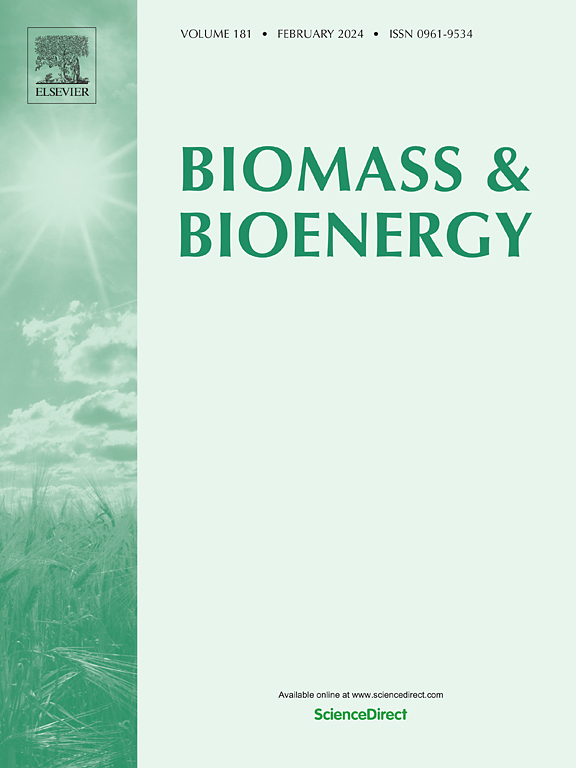Enhanced synergistic effect of acidity and active phase for Ni-Co@NHZ-5-AT on hydroconversion of benzyoxybenzene to polycyclic alkanes
IF 5.8
2区 生物学
Q1 AGRICULTURAL ENGINEERING
引用次数: 0
Abstract
Improving polycyclic alkanes (PCAs) selectivity by controlling the functional active sites of metal-acid at nanoscale for catalyzing hydroconversion of biomass is of great important in sustainable chemical industry. Herein, 10Ni-4Co@NHZ-5-AT with synergistic metal centers and Lewis acidic sites (LASs) was successfully prepared by a simple two-stage strategy. The characterization results indicated that removal Al or/and Si atoms of nano-HZSM-5 crystals through alkali-treatment could obtain the NHZ-5-AT with rough surface, more crystal defects, and strong LASs, which can improve the dispersion of Ni-Co active phases to enhance the catalytic hydroconversion performance. As a demonstration, the yields of derived PCAs (all dimers and trimers) from benzyoxybenzene (BOB) are as high as 85.2 mol% at 200 °C under 5 MPa initial H2 pressure (IHP) for 100 min. Correspondingly, the electrostatic potential distribution of BOB and derived monomers through DFT calculation indicates that > Car-OH in aromatic intermediates with multiple accessible sites is prone to bind with benzylium or benzyl radical fragments, which speculated that PACs are mainly produced from C-C coupling by inducing cation/radical fragments to activate aromatic α-C over Ni-Co@NHZ-5-AT. Especially, Ni-Co@NHZ-5-AT catalyst with synergistic Ni-Co centers and LASs can activate H2 to H…H, δ+H…Hδ−, H+, and H· to facilitate the catalytic hydroconversion of BOB to obtain PACs via multiple cascade reaction steps. These findings inspired the exploration the metal-acid bifunctional catalysts for conversion of biomass to high-density liquid fuels.
酸性和活性相Ni-Co@NHZ-5-AT对苯并氧苯加氢转化为多环烷烃的增效作用增强
通过在纳米尺度上控制金属酸的功能活性位点来提高多环烷烃(PCAs)在催化生物质加氢转化中的选择性,在可持续化学工业中具有重要意义。本文通过简单的两阶段策略成功制备了具有协同金属中心和路易斯酸位点(LASs)的10Ni-4Co@NHZ-5-AT。表征结果表明,通过碱处理去除纳米hzsm -5晶体中的Al或/和Si原子,可以得到表面粗糙、晶体缺陷多、LASs强的NHZ-5-AT,可以改善Ni-Co活性相的分散,提高催化加氢转化性能。结果表明,在200℃条件下,在5 MPa初始H2压力(IHP)下反应100 min,苯并氧苯(BOB)衍生的PCAs(所有二聚体和三聚体)的产率高达85.2 mol%。相应地,通过DFT计算,BOB和衍生单体的静电势分布表明:具有多个可达位点的芳香族中间体中的Car-OH容易与苄基或苄基自由基片段结合,推测PACs主要是通过诱导阳离子/自由基片段通过Ni-Co@NHZ-5-AT活化芳香族α-C而产生的C-C偶联。特别是,Ni-Co@NHZ-5-AT催化剂具有协同的Ni-Co中心和LASs,可以将H2活化为H…H, δ+H…Hδ−,H+和H·,促进BOB催化加氢转化,通过多个级联反应步骤得到PACs。这些发现启发了探索金属-酸双功能催化剂转化生物质为高密度液体燃料。
本文章由计算机程序翻译,如有差异,请以英文原文为准。
求助全文
约1分钟内获得全文
求助全文
来源期刊

Biomass & Bioenergy
工程技术-能源与燃料
CiteScore
11.50
自引率
3.30%
发文量
258
审稿时长
60 days
期刊介绍:
Biomass & Bioenergy is an international journal publishing original research papers and short communications, review articles and case studies on biological resources, chemical and biological processes, and biomass products for new renewable sources of energy and materials.
The scope of the journal extends to the environmental, management and economic aspects of biomass and bioenergy.
Key areas covered by the journal:
• Biomass: sources, energy crop production processes, genetic improvements, composition. Please note that research on these biomass subjects must be linked directly to bioenergy generation.
• Biological Residues: residues/rests from agricultural production, forestry and plantations (palm, sugar etc), processing industries, and municipal sources (MSW). Papers on the use of biomass residues through innovative processes/technological novelty and/or consideration of feedstock/system sustainability (or unsustainability) are welcomed. However waste treatment processes and pollution control or mitigation which are only tangentially related to bioenergy are not in the scope of the journal, as they are more suited to publications in the environmental arena. Papers that describe conventional waste streams (ie well described in existing literature) that do not empirically address ''new'' added value from the process are not suitable for submission to the journal.
• Bioenergy Processes: fermentations, thermochemical conversions, liquid and gaseous fuels, and petrochemical substitutes
• Bioenergy Utilization: direct combustion, gasification, electricity production, chemical processes, and by-product remediation
• Biomass and the Environment: carbon cycle, the net energy efficiency of bioenergy systems, assessment of sustainability, and biodiversity issues.
 求助内容:
求助内容: 应助结果提醒方式:
应助结果提醒方式:


